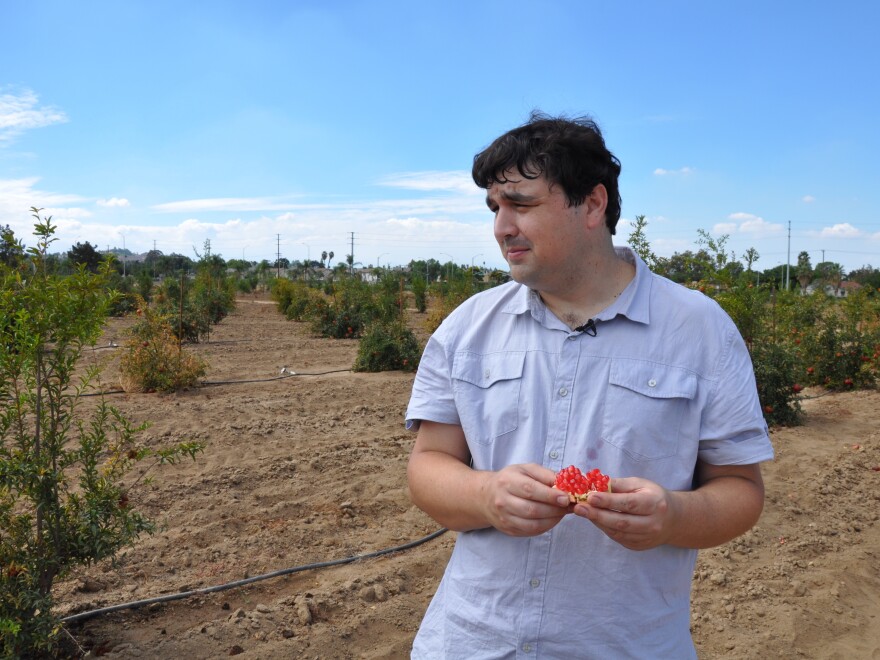Pomegranates symbolize life and vitality in many cultures. They are mentioned in the Quran, in ancient Greek mythology, and in Chinese folktales. Perhaps you bought one to split open during Rosh Hashanah, the Jewish New Year celebrated this weekend.
But for many Americans, the fruit is far too exotic for regular consumption. If you can find them, there's usually just one variety — Wonderful. It comes in a mysterious, dark-red, leathery ball containing hard-to-get jewel-bright seeds and a bitter pith, or it's already juiced and sold in a glass bottle.
"The average American has less than one pomegranate a year," says John Chater, a post-doctorate scholar studying pomegranate cultivars at the University of California, Riverside. Chater wants to change the way Americans think about the pomegranate. Specifically, he wants to introduce pomegranates that vary in flavor and color (hello, pink and yellow) and make them more mainstream.
Chater fell in love with pomegranates early in life. As a child, Chater recalls visiting his grandfather, a Lebanese immigrant, on his olive farm. Chater's grandfather, S. John Chater, grew a few types of pomegranates just for fun from seeds brought over from Lebanon. He preferred a sweet variety with soft seeds (arils, in pomegranate parlance) — nothing like the hard, red fruit most Americans know.

"I used to go over there and he would make me taste different types of pomegranates," Chater says. "When I was a kid, I thought everybody had a grandfather like this."
It turns out, everybody did not have a grandfather like this. In fact, years later, while beginning his undergraduate work in environmental studies, Chater found out that his grandfather was a bit of a cult figure in the world of exotic fruit breeding. One geneticist he met had his grandfather's photo on the wall of his office, and the U.S. government has several of his grandfather's cultivars in storage at the U.S. Department of Agriculture National Plant Germplasm System.
The NPGS, which studies the seeds and tissues of crops to safeguard diversity and support agricultural production, is interested in pomegranates because they are drought and salt tolerant. They can thrive where other fruits cannot, plus they are extremely high in antioxidants and vitamin C.
Along with his colleagues at UC Riverside, Chater is growing 13 varieties of edible pomegranates, including Parfianka, a red-skinned type with sweet pink seeds that taste like wine; Golden Globes, which are yellowish with a soft aril; and of course, the familiar red, sweet-tart Wonderful. He is studying how consumers perceive the varieties' flavors and colors, and whether they'd appeal to growers under different climate conditions.
He has also conducted taste studies published in the Journal of Food Sciencesuggesting that many consumers prefer sweeter varieties with softer seeds and less acid than the Wonderful type.
"When it comes to apples, or even peaches or plums, people like different types," Chater says, so why not pomegranates?
It may be a tough sell. For one thing, apples, peaches and plums are more popular fruits by far. In 2017, apples were the second most-popular fruit purchased in the U.S., just after bananas. Peaches were number nine, while plums came in at number 19, according to The Packer, a fruit and vegetable trade magazine. Pomegranates, considered a specialty crop, don't even rank in the top 20.
The Wonderful variety makes up 90 to 95 percent of the tiny U.S. pomegranate market, Chater says. While he has nothing against Wonderful — in fact some of his early research came out of grants made by the family that owns the brand of the same name — he thinks consumers and growers should have options.
Wonderful "has some issues," he says. It's a late-season fruit, meaning that it remains on the trees longer than other varieties. This makes it more susceptible to pests, sunburn and wind, he says. Also, if the fruit splits from the stress, it can't be sold in its whole form, it has to be sold for juice, which is not as profitable.
Some of Chater's cultivars, like Parfianka, fruit early and avoid many of these problems. Others are more adaptable to cooler, wetter climates.
"It could really help the industry" to have an earlier-ripening fruit, says Jeff Simonian, who sits on the , an organization to promote the fruit that was founded in 1997. He's also the marketing director for his family's business, , located near Fresno, Calif. He sells mainly stone fruits and a few varieties of pomegranates, and is excited about Chater's efforts — but cautious, too.
The Wonderful variety is tops for a reason — it produces a big yield and it stores and ships well, Simonian says.
Shaking up the pomegranate market would require a big educational process for both growers and the public, he adds.
But it's been done. Some new varieties of fruits introduced into the U.S. market recently have really taken off. For example, some retailers can't keep cotton candy grapes (yes, they really taste like the county fair favorite) on the shelves.
Cuties and Halos are easy-peel, fairly seedless varieties of mandarin oranges that come in five-pound boxes. They are extremely popular with the lunchbox set.
Some of the non-Wonderful pomegranate varieties have clear or light-colored arils that might be a good choice for lunchboxes because they don't stain. Perhaps the arils could be packaged in small bags the way sliced apples are now, in ready-to-eat portions, Chater says.
If Chater and his team can do something like that for pomegranates, "It would be a great thing," says Simonian.
Copyright 2020 NPR. To see more, visit https://www.npr.org.



